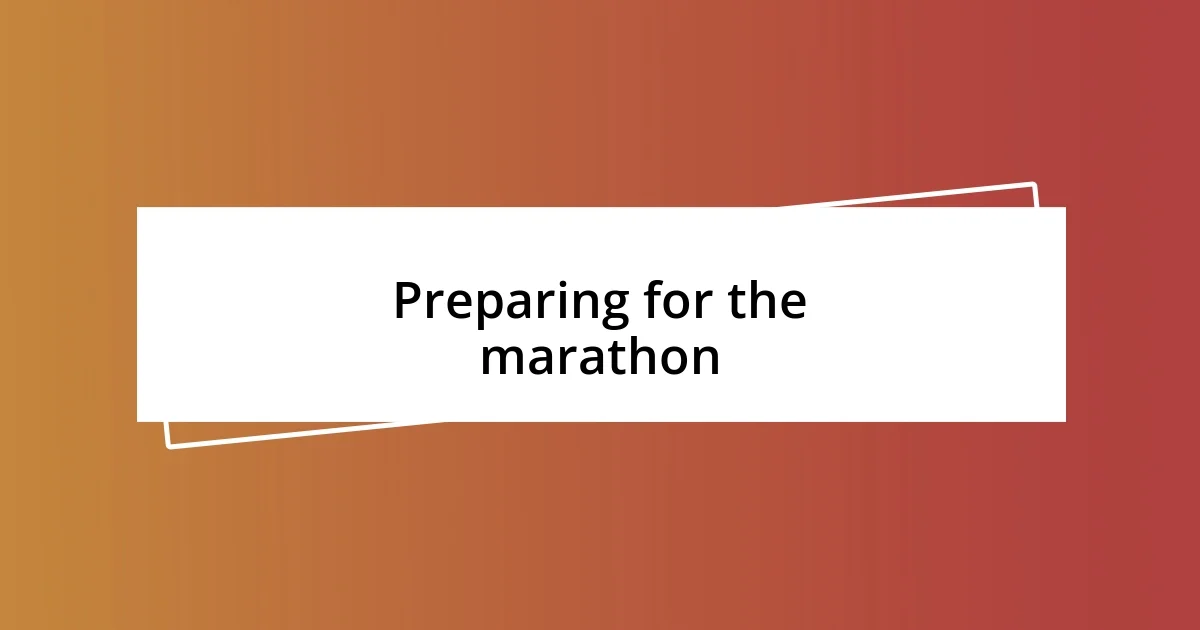Key takeaways:
- Emotional journey: Preparing for a marathon involves mental fortitude, learning to manage doubts, and celebrating small achievements.
- Effective training strategies: Key aspects include consistency, cross-training, adequate recovery, tapering, and mental visualization techniques.
- Importance of community and patience: Support from others and recognizing the need for recovery are vital for both training and post-race reflection.

Preparing for the marathon
Preparing for a marathon is not just about lacing up your shoes; it’s an emotional journey filled with anticipation and determination. I remember feeling a mix of excitement and anxiety as I mapped out my training plan. Did I have what it takes to finish? Those early doubts made every run feel significant, pushing me to prove to myself that I could rise to the challenge.
As I increased my mileage, I learned the importance of listening to my body. I vividly recall one long run when I hit the infamous “wall,” that dreaded moment when fatigue set in. Struggling through it, I realized how essential mental fortitude is—sometimes, the battle is all in your head. Have you ever felt like giving up during a tough workout? It’s in those moments that you discover your strength and resilience.
Nutrition played a crucial role in my preparation too. I experimented with different foods, finding out what fueled my runs best. On race day, the mere thought of crossing that finish line kept me focused, and I can still picture the energy gel I almost forgot to pack—thankfully, I remembered just in time! What strategies have you found most helpful when preparing for a big challenge? For me, it was all about being organized and proactive, ensuring I had everything I needed to succeed.

Understanding marathon training
Understanding marathon training goes beyond physical preparation; it’s about building a solid foundation. I always found it intriguing how the right training can transform both body and mind. The long, gradual runs built my endurance, while speed workouts left me feeling empowered. Each session taught me something new, both in terms of my limits and in tackling the mental game of running.
Here are some key aspects of marathon training I learned along the way:
- Consistency is key: Sticking to a schedule prevents burnout and injury while boosting your confidence.
- Cross-training: Incorporating activities like cycling or swimming kept my routine fresh and helped with strength.
- Recovery: I learned the hard way how important rest days are. Missing them led to fatigue and reduced performance.
- Tapering: Reducing mileage before race day felt counterintuitive at first, but it was vital for putting my best foot forward on race day.
- Mental preparation: Visualization techniques became my secret weapon. Picturing my success gave me the motivation to push through tough sessions.
Marathon training truly transformed my understanding of what I could achieve, blending physical challenges with incredible personal growth along the way.

Setting realistic goals
Setting realistic goals is crucial for enjoying and surviving your first marathon. Early on, I found myself dreaming of finishing in a spectacular time, but as I dug deeper into my training, I realized the importance of setting more achievable benchmarks. I focused on the process rather than the final outcome. Instead of stressing about crossing the finish line under a specific time, I prioritized completing each run without injury and relishing the experience of improving my stamina.
As my training progressed, I began breaking my goals into smaller, manageable chunks. For instance, my first goal was simply to run 10 miles without stopping. Achieving that felt monumental, and it kept my spirits high. Reflecting on smaller successes builds confidence, creating a snowball effect that encourages further progress. Have you ever found joy in smaller accomplishments? I’ve experienced this firsthand—celebrating each milestone made the journey far more gratifying.
Moreover, I learned to adjust my goals based on real-time feedback from my body. If a training run went poorly or I didn’t feel my best, I reassessed and adapted. Setting goals isn’t a static process; it should be flexible. Remembering that running is a journey, not just a destination, has made the entire experience more fulfilling for me. Achieving balance in your goals will guide you through the marathon’s ups and downs, fueling your passion for the sport.
| Goal Type | Examples |
|---|---|
| Performance Goals | Finish in under 4 hours |
| Process Goals | Run 3 times a week |
| Outcome Goals | Complete the marathon |
| Adjustment Goals | Rethink pacing based on training feedback |

Nutrition tips for marathon runners
Nutrition played a pivotal role in my marathon experience, and I can’t stress enough the importance of fueling your body correctly. During my training, I discovered that eating the right balance of carbohydrates, proteins, and healthy fats helped me maintain energy levels and recover faster. Carbs are your best friend—think whole grains, fruits, and veggies. They power your runs and replenish energy stores. Have you ever felt that exhilarating rush of energy mid-run? That’s what good nutrition can do for you.
Before longer runs, I made it a habit to consume easily digestible meals rich in carbs, like oatmeal or a banana. I learned the hard way that trying new foods on race day is a recipe for disaster; that one time I went for an adventurous breakfast left me regretting my choices as I ran. Sticking to familiar foods helped keep my stomach calm and focused on the miles ahead. It’s amazing how much a well-timed snack can influence your performance. I always kept energy gels handy, too, for that quick pick-me-up when my energy dipped.
Hydration was another crucial aspect that I had to nail down. I remember my first long run when I underestimated how much water I needed—it felt like running through molasses by mile ten! Drinking water before, during, and after runs became essential for preventing fatigue and cramps. I often carried a hydration pack during my longer sessions, and it was a game changer. By the time race day rolled around, I felt prepared and ready to tackle those 26.2 miles, all thanks to the right fueling strategy. How about you? Have you figured out what works best for your body yet?

Mental strategies for race day
On race day, I discovered that mental strategies can be just as crucial as physical preparation. I vividly remember standing at the starting line, heart racing and nerves tingling. To calm my mind, I practiced visualization techniques, picturing myself running effortlessly through the course. This mental imagery helped me focus on what I could control: my effort and mindset.
Another tactic that truly resonated with me was positive self-talk. I had my mantras prepared, like “I am strong” and “One mile at a time.” Each time the thought of fatigue crept in, I repeated these phrases, anchoring myself in the moment. I can’t stress enough how transformative it was to replace doubt with encouragement—suddenly, those miles seemed less daunting, and I felt empowered to push through.
Lastly, the power of staying present became my secret weapon. I often found my thoughts drifting to the distance still ahead, which could be overwhelming. Instead, I focused on the scenery, the cheering crowd, and my breath. This shift in perspective—being fully engaged with each moment—made the marathon feel more like a journey of enjoyment rather than a grueling challenge. Have you ever experienced that profound connection to the present? I can say, it made all the difference in my race.

Recovery techniques after the marathon
The days following my marathon were an eye-opener in terms of recovery techniques. One of the first things I did was indulge in a soothing foam roller session. Honestly, the way my muscles reacted to it was almost like a sigh of relief. I remember wincing at first, but as I rolled over those tight spots, a wave of relaxation washed over me. It taught me that self-massage can do wonders for lingering soreness.
I also prioritized sleep during my recovery phase. Initially, after crossing the finish line, I felt a spark of energy, but I quickly learned that my body craved rest. I made it a point to turn in early and allow my body to heal. Each night, I felt more revitalized, and it amazed me how crucial those extra hours of sleep were in restoring my energy. Have you ever noticed how a good night’s sleep can change your entire perspective? For me, it shifted my focus from fatigue to excitement for my next running adventure.
Post-race nutrition was another pivotal aspect of my recovery. I paid close attention to replenishing not just carbs but also protein to aid muscle repair. One particular evening, I whipped up a hearty quinoa bowl topped with grilled chicken and a colorful mix of veggies. It was delicious, but more importantly, it made me feel like I was actively nurturing my recovery. It sparked a sense of pride that I was taking care of my body after putting it through a marathon. After all, the right nutrition post-race plays a vital role in bouncing back stronger than ever. Have you tried experimenting with your post-recovery meals yet? It can be quite fun and fulfilling!

Lessons learned from my experience
Reflecting on my marathon journey, one lesson that stands out is the importance of setting realistic goals. At first, I aimed to run the race in under four hours, driven by a mix of excitement and naiveté. However, as the race progressed, I realized that simply finishing felt like a monumental achievement. This shift in perspective taught me that sometimes, embracing the experience is more rewarding than chasing arbitrary numbers. Can you relate to the feeling of letting go and just being in the moment?
Another valuable lesson was about the community support that comes with marathon running. I still remember the wave of encouragement from fellow runners and spectators. There was this moment around mile 15, when I was hitting a wall, and a stranger just shouted, “You’ve got this! Keep pushing!” That simple encouragement reignited my motivation. It made me appreciate the shared experience of the race and reinforced that we’re all in this together. Have you ever felt uplifted by someone’s kind words during a challenging time?
Finally, I learned that patience is key, both through training and recovery. Initially, I was eager to jump back into intense training right after the race. However, my body needed time to heal, and I had to accept that. This experience helped me understand the value of listening to my body and taking things at a pace that felt right. It’s amazing how much our bodies can teach us if we just pay attention. What lessons have you learned about patience in your own adventures?














